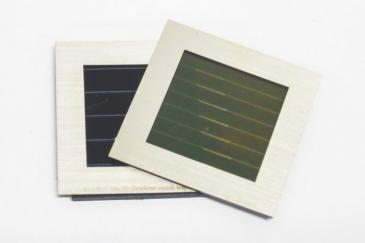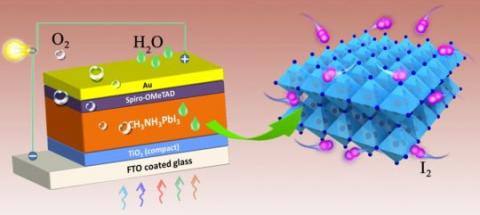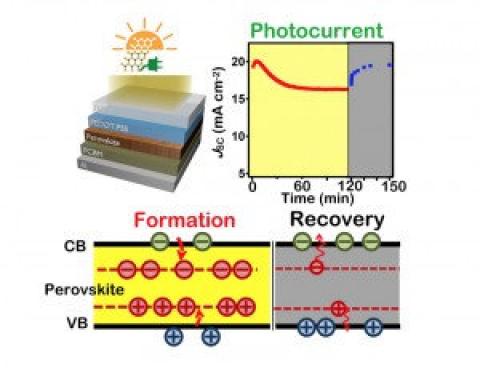 Saule Technologies is a Polish start-up that designed a low-temperature method for manufacturing flexible photovoltaic perovskite cells. The company is working on the development of a flexible and semi-transparent cell based on PET foil.
Saule Technologies is a Polish start-up that designed a low-temperature method for manufacturing flexible photovoltaic perovskite cells. The company is working on the development of a flexible and semi-transparent cell based on PET foil.
Saule's aim is to combine perovskite solar cells with other currently available products.
In December 2018, The Henn-na Hotel in Japan, a technologically advanced hotel staffed by robots, installed perovskite solar technology developed by Saule Technologies. The installed commercial prototype is made of 72 perovskite modules encapsulated in curved glass. Also in December 2018, Saule Technologies announced that Skanska has gone through with the installation of the first big format perovskite solar panel provided by Saule Technologies, integrated into its office in Warsaw, Poland. The size of the solar panel being tested on Skanska's Spark office building is 1.3 x 0.9 meters, containing 52 photovoltaic modules.
Saule Technologies has been working on the application of ink-jet printing for fabricating free-form perovskite solar modules since 2014. This technique allows the shapes and areas covered by each layer to be customized according to requirements. The stability and water resistance of the modules make them ideal for the construction industry. The company has conducted advanced research on perovskite applications in solar energy harvesting and optoelectronics with leading international universities in the UK, Israel, Germany, Italy and Spain. With a Japanese investor on board, along with support from the Polish National Centre for Research and Development and several research grants worth more than EUR 20 million, Saule Technologies is working on a large-scale, prototype production line.
In December 2014 in Boston, Saule Technologies unveiled the world's first printed perovskite.
14B Postepu Str.
02-676 Warsaw
Poland
The latest Saule Technologies news:
Imperial College team investigates the source of perovskite PVs performance issues
Scientists at Imperial College London have conducted experiments to follow the direction in which electrons move in perovskite solar cells when they are generated with a short pulse of light. They found that the mobile charged defects are still present even in solar cells with very efficient contact materials, despite these cells showing no hysteresis. Hysteresis was only found when cells suffered the combined effects of both the defects and poor selectivity at the contacts.

perovskite films contain charged defects that tend to impair their performance. Slow movement of these defects is thought to be responsible for a process known as hysteresis, which leads to irregularities in the efficiency with which light is converted to electrical current. Light-generated electricity exits the solar cell in the form of electrons to be harnessed. This is done via 'contacts' that sandwich the light-absorbing film. Previously, scientists have managed to address hysteresis by using more 'selective' contact materials that ensure a one-way flow of electrons out of the solar cell.
The root of stability challenge in pervoskite PVs may be found in intrinsic process
Researchers at OIST (Okinawa Institute of Science and Technology) have been investigating the cause of rapid degradation of perovskite solar cells. Their conclusions suggested that the degradation of MAPbI3 perovskites may not be a fixable issue, since iodide-based perovskites produce a gaseous form of iodine, I2, during operation, which in turn causes further degradation of perovskite.

In contrary to many researchers that have pointed to external sources (like moisture, atmospheric oxygen and heat) as the cause of MAPbI3 degradation, the fact that these solar cells continue to degrade even in the absence of these factors led the OIST team to believe that a property intrinsic to these cells was causing the breakdown of material.
Perovskite-rubidium pairing drives perovskite PVs to 22% efficiency
Researchers at EPFL (Ãcole Polytechnique Fédérale de Lausanne) in Switzerland have stabilized perovskite solar cells by integrating metallic element rubidium into them, driving power-conversion efficiency to a staggering 22%.
The research outlines the integration of rubidium cations into perovskites; The perovskites maintained stability for more than 500 continuous hours in full sunlight at 85°C. The project team has already submitted a patent based on their innovation.
Perovskite material could increase output power of vacuum electronics
Researchers from the University of Wisconsin'Madison have discovered that a perovskite material could greatly enhance the technology of vacuum electronics. The material is capable of promoting the output power of the electron beam, and enables remote sensing and long-distance communications for a much lower energy cost than currently spent.
The researchers received a $1.3 million grant from the Defense Advanced Research Projects Agency. They aimed to synthesize large quantities of the material and additionally analyze its properties. They also hope to locate other applications where this concept can be utilized.
Perovskite solar cells degrade in the sunlight but can "heal" in the dark
Researchers at the Los Alamos National Laboratory (LANL) in New Mexico, USA have found out why perovskite solar cells degrade in sunlight, as well as how the devices can 'self-heal' by being given time in the dark. The research, that determined that photo-degradation in perovskite cells is a purely electronic process due to charge accumulation without chemical damage to the crystal structure, could help catalyze the promising solar technology.

The new finding, that organometallic halide semiconducting perovskite solar cells degrade under continuous sunlight but recover in the dark is seen as very good news as it means the process is of physical nature rather than chemical decomposition. According to the researchers: 'After extensive characterization electronically and optically, we found it was the charge accumulation in the cell that reduces the photo-generated electrical current. Our team predicts the charge accumulation is initiated by the charged trap states, called small polaron states, which is only activated under light.'
Saule Technologies secures Japanese investor
 Saule Technologies has signed an investment deal with Hideo Sawada, a Japanese investment company. Saule aims to combine perovskite solar cells with other currently available products, and this investment agreement came only a year after the company was launched.
Saule Technologies has signed an investment deal with Hideo Sawada, a Japanese investment company. Saule aims to combine perovskite solar cells with other currently available products, and this investment agreement came only a year after the company was launched.
Pagination
- Previous page
- Page 4